Albaicín
The Albaicín (Spanish pronunciation: [alβajˈθin]) or Albayzín (Arabic: ٱلْبَيّازِينْ) as it was known under Muslim rule, is a district of Granada, in the autonomous community of Andalusia, Spain. It retains the narrow winding streets of its Medieval Moorish past dating back to the Nasrid Kingdom of Granada. It was declared a World Heritage Site in 1984, along with the Alhambra.
| UNESCO World Heritage Site | |
|---|---|
.jpg) View of the Albaicín | |
| Official name | El Albayzín |
| Location | Granada Province, Spain |
| Part of | Alhambra, Generalife and Albayzín, Granada |
| Criteria | Cultural: (i), (iii), (iv) |
| Reference | 314bis-002 |
| Inscription | 1984 (8th session) |
| Extensions | 1994 |
| Coordinates | 37°10′54″N 3°35′54″W |
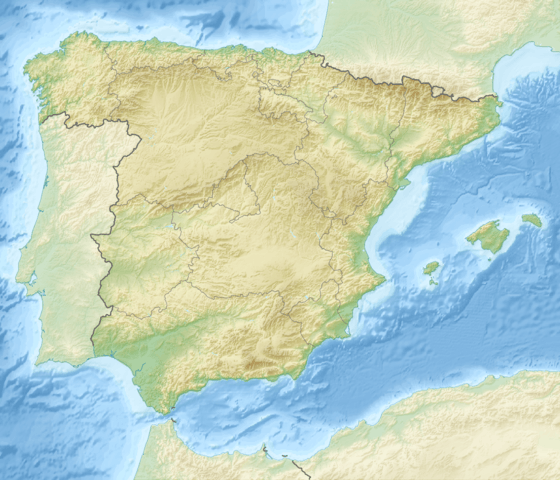 Location of Albaicín in Spain | |

History
The area that later became the Albayzín was first populated by the Iberians, the original inhabitants of the Iberian peninsula, with dispersed Roman settlements later appearing nearby. Nothing is known of its history before the arrival of the Muslim Berbers, so it is assumed that the city was abandoned after the fall of the Roman Empire until the founding of the Zirid kingdom in 1013, when its defensive walls were built. According to some linguists it owes its present name to the inhabitants of the city of Baeza, called "Beatia" by the Romans, who were banished after the Battle of Las Navas de Tolosa and settled here outside the walls. Other linguists assert that the name derives from the Arabic al-bayyāzīn (pronounced al-bayyīzīn with the imāla vowel-shift), meaning "suburb of falconers". However, the fact that in Andalusia there are many other neighborhoods with that name, including those in Sanlúcar de Barrameda, Alhama de Granada, Salobreña, and Antequera, among others, casts doubt on this thesis. A more likely hypothesis is that the name of Albaicín derives from Arabic البائسين (al-bāʾisīn, 'the miserable' [plural]).[1]
The Albaicín, one of the oldest centers of Muslim culture in Granada, contains the Alhambra, the Realejo (which was the Jewish quarter), and the Arrabal de Bib-Arrambla, in the flat part of the city. Before the Muslim conquest of the Iberian Peninsula there were three small settlements in what is now the city of Granada and its surroundings:
- Iliberis (Elvira), later called "Albaicín" and "Alcazaba"
- Castilia, near the present town of Atarfe
- Garnata, on the hill opposite the Alcazaba, which was more a neighborhood of Iliberis.
However, current archaeological research indicates the Madinat Ilbira (Medina Elvira) was located in Atarfe when that city's population was moved to the Albayzín after the fall of the Caliphate of Córdoba in the 11th century. The inhabitants of Ilbira remained clients of the Berber Sinhaya and the Zirids until the capital of the Cora of Elvira was transferred to the Albayzín hill. The neighborhood had its greatest influence at the time of the Nasrids. The Albaicín maintains the urban layout of the Moorish period, with narrow streets winding in an intricate network that extends from the top at San Nicolás and through Calle Elvira, both located in Plaza Nueva, by the course of the river Darro.
The traditional type of house is the carmen, consisting of a freestanding house surrounded by a high wall that separates it from the street and including a small orchard or garden. The channeling and distribution of drinking water through pipes laid from wells was characteristic of this district; about 28 of these have been found, of which most are preserved but not in use because the pipes were broken over time.
In December 1499, the Albaicín was the starting point of a rebellion throughout Granada, triggered by the forced conversion of the Muslim population to Christianity.[2]
In 1994, the Albaicín was declared a World Heritage site by UNESCO as an extension of the monuments of the Alhambra and the Generalife.[3]
Places of interest
In the Albaicín there are numerous monuments from different periods, mainly the Nasrid period and the Renaissance:
- Ziri wall (11th century), established along the Sacromonte and Albaicín.
- New door or door of Weights, the Granadian people call and know it as arc of weights.[4]
- Fajalauza door in Cuesta de San Gregorio Alto, part of the wall.[5]-[6]
- Alhacaba Towers, part of the wall.
- Monaita door in Lona Lane, part of the wall.
- Puerta de Elvira, at the beginning of Calle Elvira, part of the wall.
- Church of El Salvador, in the Cuesta del Chapiz.
- Church of San Miguel Bajo, in the small square of San Miguel Bajo, with a Mudejar armor and a cistern of the 13th century.
- Church of San Gregorio, at the beginning of the Cuesta de San Gregorio.
- Church of San Cristobal and viewpoint with the same name, in Crta. De Murcia
- St. Louis. Temple without worship and in ruins.
- Church of San Juan de los Reyes, in the street San Juan de los Reyes.
- The Great Mosque of Granada (Mezquita Mayor de Granada). Built in 2003, it is the first mosque constructed in Granada after the city came under Catholic control in 1492.
- Palace of Dar al-Horra, Aixa's residence, Muley Hacén's wife and the mother of Boabdil.
- The Bañuelo.
- Minaret of Almorabitun.
- Trillo cistern.
- House of the Masks, in the street Pagés, what remains of the house of the poet Pedro Soto de Rojas (17th century).
- House Yanguas (16th century), at San Buenaventura, hodgepodge of Nasrid and Renaissance architecture. Currently, a Tourist hotel.
- Church of Santa Ana, at the beginning of the Carrera del Darro.
- St. Peter & St. Paul, in the Carrera del Darro.
- Hermitage of San Miguel alto, Lane San Miguel.
- Casa de Porras, in Placeta de Porras, Moorish house of the 16th century, today the University Cultural Center of the University of Granada.
- Casa del Almirante (Aragon), Calle San José, 16th century.
- Castril House (1539) in the Carrera del Darro, Current Archaeological Museum of Granada.
- Lona House in Lona Lane, on the site of the former palace of the kings Ziries.
- Cordova Palace (16th century) in the Cuesta del Chapiz, current Municipal Archives.
- Casa del Chapiz, This was built on the remains of a Moorish palace of the 14th century, which preserves part of the layout of the plant and some elements that were utilized when it was rebuilt in the early 16th century by the Morisco Lorenzo el Chapiz, whose name is preserved in the set and the street where it is located.
- Casa de Zafra, 14th Century Spanish-Arab mansion, re-opened as Interpretative Center.[7]
- Statue of the artist G.O.W. Apperley RA RI (1884-1960), unnamed square off Calle Gloria.
Gallery
- Houses in the Albaicín
- Typical house façade in Cuesta de Alhacaba
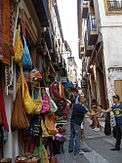 Calderería street
Calderería street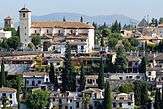 Church of San Nicolas and Albaicín from Alhambra palace
Church of San Nicolas and Albaicín from Alhambra palace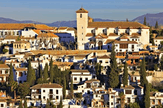 View of Saint Nicholas church and the Albaicín mosque
View of Saint Nicholas church and the Albaicín mosque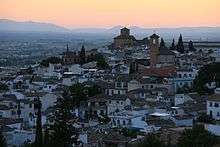 Albaicín
Albaicín- Alhambra and Albaicín by night
.jpg) Narrow alley
Narrow alley
19th century paintings of Albayzín
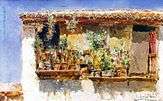 A balcony in the Albayzín by painter M. Arroyo Fernandez in 1891, stored at Biblioteca Provincial de Granada
A balcony in the Albayzín by painter M. Arroyo Fernandez in 1891, stored at Biblioteca Provincial de Granada.jpg) Casa del Chapiz in the Albaicín by Francesc Pi i Margall and Francesc Xavier Parcerisa in 1850, published in the work Recuerdos y bellezas de España
Casa del Chapiz in the Albaicín by Francesc Pi i Margall and Francesc Xavier Parcerisa in 1850, published in the work Recuerdos y bellezas de España Procession of the Viaticum on the street of Zafra, the Albaicín by Manuel Ruiz Sanchez Morales (1853-1922), stored at Biblioteca Provincial de Granada
Procession of the Viaticum on the street of Zafra, the Albaicín by Manuel Ruiz Sanchez Morales (1853-1922), stored at Biblioteca Provincial de Granada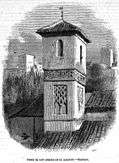 Tower of San Lorenzo in the Albaicín. Drawing by Federico Ruiz (1837-1868), engraving by Edward Skill (1831-1873), published in the Spanish magazine El Museo Universal
Tower of San Lorenzo in the Albaicín. Drawing by Federico Ruiz (1837-1868), engraving by Edward Skill (1831-1873), published in the Spanish magazine El Museo Universal
See also
References
- Arab World. 8–14. 1962. p. 23.
- Carr, Matthew (2009). Blood and Faith: The Purging of Muslim Spain. New Press. pp. 58–59. ISBN 978-1-59558-361-1.CS1 maint: ref=harv (link)
- "Alhambra, Generalife and Albayzín, Granada". UNESCO Culture Sector. Retrieved 2013-02-09.
- Plano árabe de Granada de Luis Seco de Luna
- Granada, Ele Medios, Álvaro de Bazán 9 3º Derecha, 18010. "Puerta de las Pesas :: AGENCIA albaicín GRANADA". www.albaicin-granada.com (in Spanish). Retrieved 2018-02-22.
- GALLEGO Y BURÍN, ANTONIO. "Guía artística e histórica de la ciudad de Granada", página, 781. Edición: Guía de Granada 1946.
- Galán, Daniel (2015-11-04). "La casa de Zafra: 6 razones para visitar este monumento del Albaicín". EL VIAJE DEL MAPACHE. Retrieved 2016-10-22.
External links
| Wikimedia Commons has media related to Albaicín. |
- Albayzín on ArchNet, retrieved October 24, 2006
- World Heritage page on Albayzín , retrieved October 24, 2006
- Albayzín in turgranada.es Official Site for tourism of the province of Granada
- Albayzín in granada-in.com Itineraries by the district of the Albaicin (in Spanish)
- Webcam Albayzín - Granada/Alhambra
- Granada - albaicin (photo's)